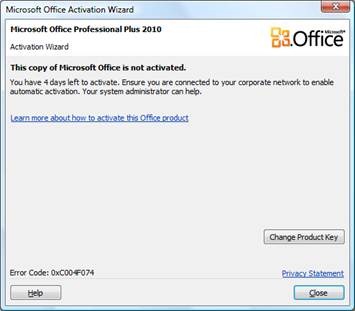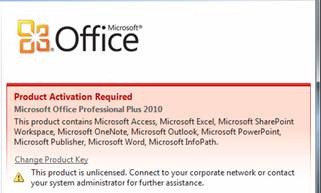Office 2010 Activation Methods
One of the new features of Office 2010 for volume license customers is an overly complicated activation method. You now no longer have the ability to build an Office installer executable that includes the proper license key. Your two options for activation are:
- KMS (Key Management Service)
- MAK (Multiple Activation Key)
MAK will be the most familiar to most people. It is simply a license key that you can use to activate Office 2010 on an individual PC. The easiest way to activate an Office install is to wait for the activate nag window to pop-up, select the Change Product Key button, and enter the MAK. The KMS method requires installing KMS on a server on the Windows domain that can service the activation requests.
You’ll know you need to activate an Office 2010 volume license when you see a couple telltale signs:

The activation nag screen will pop-up when starting any office application.

The red bar across the top stating that activation has failed and you are now in limited mode will show up after activation has failed and the grace period has elapsed.

The Office 2010 about page can be seen by going to the File tab > Help.
If you have more than 5 PCs to activate, and you should for a volume license, the KMS activation method will be the easiest. First, install Key Management Service 1.1 for your 32 or 64bit system. You can download the appropriate version here:
- Key Management Service 1.1 (x86) for Windows Server 2003 SP1 and Later
- Key Management Service 1.1 (x64) for Windows Server 2003 SP1 and Later
After running the installer, there is also a windows update that needs to be run. Install the update and reboot if necessary. Then install the Microsoft Office 2010 KMS Host Licens Pack which can be found here:
The installer will ask for your KMS License Key for Office 2010 which you can get from your licensing portal. The Office 2010 installer your downloaded from the licensing portal will already contain your KMS client key which it uses when contacting the server.
Once all the KMS components are installed, you need at least 5 computers to contact the KMS server and join it’s KMS pool. Until the KMS pool consists of at least 5 computers, all activations will fail. You can check the status of the pool size by running the following command on the KMS Server:
C:\WINDOWS\system32>cscript slmgr.vbs /dli or
C:\WINDOWS\system32>cscript slmgr.vbs /dlv for more inforamation.
Then you’ll see a response like the following:
Name: Office(TM) 14, Beta1ProPlusKMSHost edition
Description: Office(TM) 14 KMS, VOLUME_KMS channel
Partial Product Key: TCDMC
License Status: Licensed
Key Management Service is enabled on this machine
Current count: 6
Listening on Port: 1688
DNS publishing enabled
KMS priority: Normal
The current count item is the one needs to show at least 5. In order to increase the count, you can open unactivated copies of Office 2010 on your computers that will then be added to the KMS pool. These computer need to be part of the windows domain in order for this to work since the KMS server is found through the local domain’s DNS.
You can also force Office 2010 to attempt an activation by issuing the following command on the client computers:
c:\Program Files\Microsoft Office\Office14\cscript ospp.vbs /act
A complete command line reference for ospp.vbs can be found here:

Comments
Nice article about MS Office Activation. Thanks.